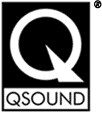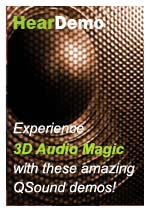QSound Origins
QSound inventors Danny Lowe and John Lees’ original research was based on phenomena experienced in the recording studio as a result of experimentation with multiple microphones. Eventually they were able to achieve the impression of sound apparently originating from thin air, far beyond the normal limitations of the stereo sound stage.
After initial analysis of audio tape recordings, a series of experiments was conducted using a Hewlett Packard signal generator and an Eventide Clockworks Precision Delay. Though the latter was hardly a laboratory-grade instrument, the two men were able to demonstrate the possibilities well enough to raise interest and research capital.
- Armed with the results of this crucial early work, Lowe and Lees assembled a team of scientists and audio professionals.
- Software tools for sound analysis and modeling, test signal generation and statistical data analysis were custom developed in house, exploiting the newly available power of purpose-designed DSP (digital signal processor) IC’s and desktop computers.
- QSound entered into an intense research phase, modeling sound wave propagation from loudspeakers, extrapolating promising theories for further exploration.
- Human listeners were presented with carefully designed test signals which had been passed through the initial process algorithms and delivered through stereo speakers in several controlled environments.
- Listener responses were captured using a custom data entry system consisting of multiple hand-held electronic keypads and a central data collector.
- As the system operators adjusted various characteristics of the test signals and process algorithms, analysis of the data was performed using a combination of software and skilled human judgement.
- As trends emerged, the processes were refined, retuned, retested and further refined in an iterative procedure taking place over many months. A key element in this task was the participation of team members having a background in the professional audio recording industry.
- In all, over 550,000 listening tests were performed, using a variety of subjects in order to produce averaged results leading to algorithms effective for virtually any listener.
Due to the imperfections and inefficiencies produced by taking a legitimate binaural model and adapting it to speakers through additional crosstalk cancellation, the QSound team concentrated directly on the target environment: the human perception of sound location as presented through stereo speakers.
The result was arguably the world’s most natural-sounding, effective, and inherently efficient positional 3D audio algorithms for stereo speakers. In practical consumer applications such as desktop computers and mobile devices, the efficiency advantage over the combination of binaural synthesis with crosstalk cancellation should not be underestimated, as it has a direct impact on system compute and memory requirements and therefore product cost.
This initial algorithm development became the basis of the first commercial applications developed by QSound, the core of the QSystem hardware processor that was applied to the production of professional music releases and movie soundtracks, and became the foundation for what was to become the most complete suite of 3D algorithms available.
More information about QSound audio technology >>

